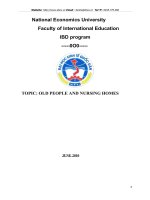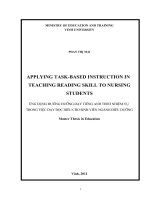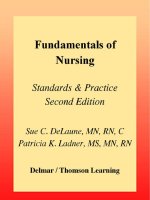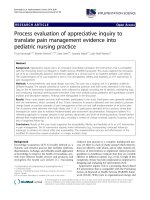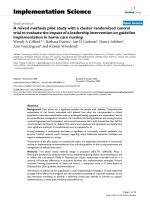Nursing Standards Nursing Theories
Bạn đang xem bản rút gọn của tài liệu. Xem và tải ngay bản đầy đủ của tài liệu tại đây (317.24 KB, 43 trang )
Nursing Standards &
Nursing Theories
Delaune & Ladner Ch 2, Roy
Chapter 2
Elements of a Profession
Provide service to support social welfare
Possess a specialized body of knowledge
Educate its practioners in institutions of higher
learning
Life long commitment
Formulates policy and controls its membership
Practitioners function autonomously
Have a Code of ethics
Have a professional organization that contributes
and ensures quality of practice
The Nursing Profession
Nursing is both a profession and a practice
discipline.
The professional nurse is an occupation that
requires extensive education, specialized
training and competence.
Nursing services are delivered in variety of
settings.
The amount of autonomy and accountability
for decisions differs with the practice setting.
Another Definition of Nursing
Nursing is concerned with the health and
well being of clients/patients.
It involves the delivery of services to
promote, maintain, and restore health as
well as prevent illness.
Nursing also coordinates services to
improve continuity of care.
Nursing Is a Science
Science
A process of research and inquiry
empirical knowledge
examination of phenomenon
definition and consensus of terms
model building
theory testing
Nursing is not Medicine
Uses a similar body of knowledge
BIO, psych, chem…..
Medicine diagnosis, to cure
Nursing diagnosis to facilitate change
Nursing holistic wellness focus
Nursing is a Science
Based on theories
Supported by research
That defines describes and directs practice
A Science Is a Process That:
Identifies to categorize and structures in
order to understand and manipulate
The statements of science are :
“true”
coherent
logically ordered
focused on definite areas
result in universal statements
Two Major Types of Research
Quantitative/ empirical
Observed and measured
Give us numbers, numerical data
Relationships revealed in statistics
Qualitative/Ethics, Esthetics, Personal knowing
Observed and described
Give us stories, narrative data
Relationships revealed in patterns
Knowledge development
Combination of scientific and research
process
Documentation and analysis of cause and
effect
Result is theories that organize and
communicate concepts
Theory
An idea or set of concepts that describe,
organize or explain a phenomenon
Describes relationships between significant
constructs within the theory
Theories
Evolve
Are tested by research
Contain elements of assumption
Contain agreed upon definitions
Theories Roy, Pg 87, Delaune pg 27
Grand –Give us broad definitions, very abstract,
Meta theories.
Systems, situation producing theory.
Middle range.
Man, society.
Nursing focus, family dynamics, stress, maternal
bounding.
Practice – Micro.
goal directed, research related to proper tube feeding.
Example
The biological system
called man can be
assisted in preventing
illness by nurses
giving immunizations.
Meta
Grand
Middle range
Practice
Theories Example
Often Require
Mathematics
Elements of Agreement
0 X 1 = 0 Agreement 0 Not 1
Chemistry
The Ph of Water Is 7.0, Not 10.0
Selected Models and Theories
Systems theory – operations, biology
Maslow Needs theory - motivation
Roy adaptation model – nursing
Systems Theory
Assumption/agreements
Relationship exists between the whole and
its parts
The whole is more than a sum of its parts
A system is goal directed
An open system changes - evolves
Systems have boundaries - open/closed
Systems Theory
Input
Out put
result of process
Through put
raw materials
work of the system
Feedback loop –
message that becomes part of input
Systems Theory
Input
Knowledge
Skills
Abilities
Raw material
Throughput
Process
Analysis
Feedback
Evaluatio
n
Internal environment
External environment
Output
Products
Decisions
Example GI System, Newborn
Child, First Feeding
Input - anatomy, food, water.
Through put - digestion.
Out put - waste, energy, water.
Feedback - some food tastes better, digests
easier and causes less gas.
Input - anatomy, different foods, new enzymes
for digestion.
